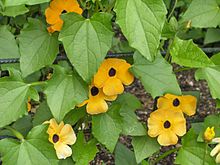| Thunbergia | |
|---|---|

| |
| Flowers of Thunbergia alata | |
| Scientific classification | |
| Kingdom: | Plantae |
| Clade: | Tracheophytes |
| Clade: | Angiosperms |
| Clade: | Eudicots |
| Clade: | Asterids |
| Order: | Lamiales |
| Family: | Acanthaceae |
| Subfamily: | Thunbergioideae |
| Genus: | Thunbergia Retz. (1780)[1] |
| Species[2] | |
|
150; see text | |
| Synonyms[2] | |
| |
Thunbergia is a genus of flowering plants in the family Acanthaceae. It includes 150 species native to tropical and subtropical regions of sub-Saharan Africa, Madagascar, southern Asia, New Guinea, and Australia.[2] Thunbergia species are vigorous annual or perennial vines and shrubs growing to 2–8 m tall. The generic name honours the Swedish naturalist Carl Peter Thunberg (1743-1828).
Its members are known by various names, including thunbergias and clockvine. Thunbergia on its own usually refers to Thunbergia grandiflora, while Thunbergia alata is often known as black-eyed Susan vine or just black-eyed Susan (not to be confused with other flowers called black-eyed Susan). Orange clockvine is the name of Thunbergia gregorii.
Thunbergias are frequent garden escapes, becoming invasive species; T. grandiflora, T. fragrans, and T. laurifolia are considered weeds in Australia.[3]
- ^ "Genus: Thunbergia Retz". Germplasm Resources Information Network. United States Department of Agriculture. 2007-10-05. Archived from the original on 2012-10-09. Retrieved 2010-10-30.
- ^ a b c Thunbergia Retz. Plants of the World Online. Retrieved 7 February 2024.
- ^ Weeds Australia, National Weeds Strategy, retrieved 27 March 2015